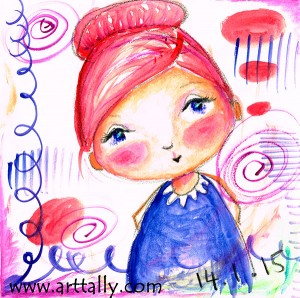How to set up your new project for success
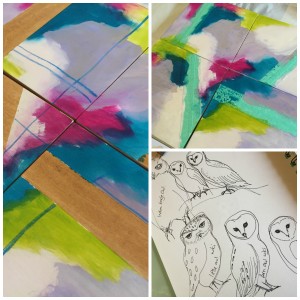 I start a new project every month. It's very exciting, but also a little scary. This month I am painting a series of square mixed media panels that feature animals. Last month it was flower faces on paper (see the finished gallery here!)
I start a new project every month. It's very exciting, but also a little scary. This month I am painting a series of square mixed media panels that feature animals. Last month it was flower faces on paper (see the finished gallery here!)
On the first working day of each month I get a fresh start. Here are five ideas to consider so that you set up your new project for success.
1.Start with why.
Try and articulate for yourself exactly why your are doing this project. Being clear about your purpose will enable you to evaluate your progress more fairly. It will be your guide post as you need to make decisions during the project. Simon Sinek explains that getting to the heart of why we do what we do is to tap into our own infinite source of inspiration and motivation.
2. The honeymoon phase
Enjoy the initial burst of enthusiasm that heralds the start of a new project. Celebrate it. Know that it is a part of the energy cycle of the project and it wont last. Anticipating this means you can try to avoid being disappointed that you didn't maintain your momentum or beat yourself up about it when the enthusiasm wanes. But make the most of the initial excitement - it is the impetus that gets you started.
3. Identify your requirements and resources.
Usually we are pretty good at figuring out what we are going to require in terms of materials for a project. But there is more to consider in preparing your project for success. Don't overlook the project's requirements in terms of time and support. Be realistic about how much time you will need to put in as well as any time requirements for other team members. Consider the resources you have available. Access to a mentor for example, can be an important resource, as can access to other additional help such as substitute/alternate team members or alternate suppliers as a back up in case of emergency.
4. Baby steps
How do you eat an elephant? One bite at a time. Even the most daunting task can be made easier to approach by breaking it down into small achievable steps. Once you have an idea of the steps, you can measure your progress by measuring the process rather than results. Your chances of success are far greater if you can focus on your systems rather than just your ultimate goal.
5. Give yourself a buffer.
Nothing goes according to plan. Where would the fun be in that anyway? But when things go awry it can knock you off schedule. Be kind to yourself and build in a bit of extra time in your schedule to deal with the unforeseen.
Why parenting teaches entrepreneurs about unstructured time and self discipline
Becoming an entrepreneur can be as overwhelming as becoming a new parent
Parenting teaches entrepreneurs about unstructured time and self discipline. A new parent is dispatched home with a sweet smelling bundle of joy, only to find themselves stepping into a sort of parallel universe. Day and night blur exhaustingly into one. Time loses its meaning. Day to day tasks that were once second nature like regular meals, doing laundry and managing to wear matching shoes become challenging.
That blur of overwhelm is very similar to the experience of the newly self employed. In fact, any significant life change that removes the structure of your day like children going to school or leaving home, being made redundant or retiring, can leave you with an an unsettling amount of unstructured time.
Unstructured time is not as brilliant as you might have hoped…
If you chose the change, unstructured time might be exactly what you were after. But sometimes it is not all you had hoped it would be. Studies have linked the increase in unstructured time experienced by those who are unemployed to low self esteem, hopelessness and inactivity . With too much time on our hands we end up having to face our demons. And with unstructured time the most likely outcome is often a significant lack of productivity.
Hopefully you find a creative endeavour to utilise this time. If the change was of your choosing, as in the case of the new entrepreneur this creative project might be the very reason for the change. You start a business, change career, write a novel, take up a hobby. That creative project is your new baby.
However, unlike the newborn baby your new project won't wail to let you know when you have missed an important activity like time for a feed or a nappy change. No, your new project is entirely silent. It is all on you to figure out what to do and when to do it.
Reduce that overwhelm with a solid structure
Most new parents learn pretty fast that the best way to manage this enormous life change is with a steady routine. That fuzzy haze of the first few days or weeks clears once a consistent schedule is established. And with a newborn baby, there are usually plenty of knowledgeable friends and relatives, who are more than willing to provide input.
Similarly, to thrive (or just survive) your new creative endeavour you have to manage that unstructured time with… yes, I’m afraid so… a bit of structure. It might be that unstructured time is what you wanted, but actually it is more like self-directed time. Maybe what you wanted was not to be answerable to anyone - unstructured time is the initial side effect.
Okay, so there are no busybody relatives and parenting gurus clamouring to be involved in what you do. But resources are readily available to help you come up with a structure. They are all largely common sense, as most good advice is. They likely begin with an assessment of goals and objectives. The next step is to break down the steps needed to achieve those goals and objectives. And finally, to schedule those priority tasks.
The key to success is self discipline
However, scheduling is not the final step at all. I think that this part is comparatively easy compared to the critical final component. Execution. Actually carrying out the tasks that have been scheduled. A crying baby is hard to ignore. You complete the necessary tasks without really thinking about it because the need, goals and objectives are obvious and time is scarce.
But with the new creative endeavour, it is easy to lose sight of the goals, and to lose the sense of urgency. The only thing that keeps us executing the tasks on our list is self discipline.
Business gurus like Bob Proctor and Brian Tracy advise that self-discipline is the most important characteristic of an entrepreneur. Often, the most productive time of our life is our school days. Thanks to a rigorously enforced and carefully thought out structure, we learn multiple subjects and skills, and include play, exercise and hopefully healthy eating on a daily basis.
Unfortunately, without teachers and parents and bosses we are accountable only to ourselves. With only self discipline to keep us on track we probably won’t achieve the volume and variety of learning and productive activity per day as we did at school. Nor do we always remember to take care of ourselves as well as we should. The most essential tool in our arsenal for success is self discipline.
Fortunately, self discipline is a learned skill. If it doesn't come naturally to you, you can still improve it with some effort.
Schedule out every part of your day. Do this before the day begins - at least the night before. Then follow your schedule unwaveringly, whether you feel like it or not. The sense of achievement when you carry this out is very motivating. Do it again tomorrow. And the next day.
Will you be able to do this every single day? Probably not. Don’t be too hard on yourself. We all have off days. Aim for the 80/20 rule… try and do this at least 8 out of every 10 and see your productivity sky rocket. Your self esteem and mental state will benefit too. Like anything, the more you practice, the easier it becomes.
Learn to illustrate with Danielle Donaldson
Creative Girls with Danielle Donaldson
I have been taking Danielle Donaldson’s delightful class at the Jeanne Oliver network. I have always loved drawing little characters and I have been trying to learn to illustrate by taking classes with as many different people as possible so that my own characters eventually find their own style. I am enjoying watching how my girls morph from Jane Davenport girls to Juliette Crane girls to Danielle Donaldson girls. I think with each transformation they retain a little something from each experience. I am fascinated to see how they end up. Maybe there is no ‘end’. Perhaps the point is that our drawings taking on a life of their own and perpetually evolve. I like that idea.
What is in the class?
This course covers character building, journal making, a little lettering and perspective and is mainly using watercolours which I am currently in love with. (Mercifully, as I was off to a bit of a rocky start with an early attempt at ‘traditional’ watercolours!)
Here are my Danielle-ish girls. I even played with my twinkling H2Os for the first time. Danielle doesn’t use those in the course - I just couldn’t resist giving the girls a bit of bling in a rather subtle way. Hmm.. Is that possible?…subtle bling?
Themed journals
I love the idea of a themed journal like this one that Danielle teaches you to put together. I didn't opt to bind my own journal although I do love doing that too. At the moment I have set my book up as Danielle instructs and I am trying not to feel scared of messing it up… I’m working in pencil like Danielle which is unusual for me - never been a fan of graphite but… yippee, you get to erase!
Cover Girls
Danielle’s cover girl is a character called Bad Penny. She is super cute. However, I couldn't quite bring myself to call any of my characters ‘bad’ … so I have a different Danielle-ish girl. I have popped her on the first page in my journal. I might recreate her on a separate sheet and stick her onto the cover of my journal eventually.
Working small
The course also teaches you to work small to build up confidence in developing illustration skills. This is an idea close to my heart, as I first learned the appeal of working in a teeny journal when I took one of Joanne Sharpe’s classes Draw Your Awesome Life, which I also highly recommend.
Perspective
Another part of the class I have really enjoyed is learning perspective. Danielle incorporates just enough of the technical skills of perspective to really help make more lively, realistic (and yet still whimsical) drawings. There is not so much of the technical skill building to stop the class feeling like fun as opposed to school. Look at my chairs… who knew drawing cute little chairs could be so fun?
This class is Danielle’s second creative girls class on Jeanne Oliver's network. I never took the first one, but after taking this class I think I might have to.
Art and the importance of play
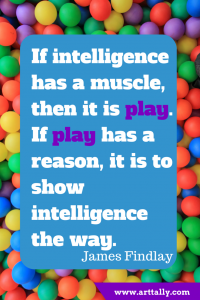 The importance of play
The importance of play
Quite a few years ago I was in the middle of a very long study programme. I was working. I had two small children. Every minute of my day seemed scripted. It also seemed to be mostly for satisfying other people’s needs. Then, seemingly out of the blue, I got it into my head that I wanted to learn the piano. I had never played an instrument before. I didn't have a piano. And I was very busy doing other ‘important’ things. But for some reason I heeded the call. I hired a digital piano, bought myself an online piano course and started to learn.
I’m so glad I did - despite that little voice in my head that kept saying What are you doing? This is so silly… Isn't it a waste of money? You really don't have time for these needless things…
But that was just the point. I needed exactly that. Something needless. Something just for me, that didn't really matter. I could be good at it or bad at it. Do it often or seldom. It was just for fun. I wanted to play.
What is play?
In his TED talk, Dr Stuart Brown used the word needless to explain what play is. He describes play as an activity that is more about process than outcome, that is done purely for enjoyment. He also says the opposite of play is depression. Play is vital.
Play is not just something children do in preparation for adulthood but a biological process necessary in all phases of life. Neuroscientists have worked out that play lights up our brains - there is even an entire scholarly journal dedicated to it, The American Journal of Play!
We all need to make time in each day for a bit of fun - a chance to play, even adults. In fact, I want to say, especially adults. Everyone agrees fun and play is important for children but we tend to overlook these things in adulthood. It was in watching my small child drawing that I realised grown ups need to play too - in fact that is what started my art journey.
Art is play
For me, art is play. According to the National Institute for Play, there are seven types of play:
- attunement play
- body play and movement
- object play
- social play
- imaginative and pretend play
- story telling and narrative play
- creative play.
Making art encompasses several of these. Artists work with their hands, manipulating objects such as pens, brushes, clay, paper. Working with our hands (object play) has been identified as an important way in which our brains develop problem solving abilities
Making art is a chance to escape into a fantasy world for a brief time, satisfying our need for self expression and developing the neural pathways required for innovative thinking (creative play).
Anyone who has every kept an art journal will be in no doubt that this process helps us to explain, describe and make sense of our world. This is what story-telling and narrative play is all about.
Daily play
Dr Dan Seigel recommends dividing our time between seven essential mental activities every day, for optimum health:
- sleep time
- physical time
- focus time
- down time
- time in
- play time
- connecting time
These things make up what he describes as our healthy daily platter - the mental equivalent of healthy food plate. Alongside things like sleeping, working and exercising we should be consciously setting aside play time.
How funny it is that once we become adults we need to be told to go and have some fun every day…
“Play is the gateway to vitality.
By its nature it is uniquely and intrinsically rewarding. It generates optimism, seeks out novelty, makes perseverance fun, leads to mastery, gives the immune system a bounce, fosters empathy and promotes a sense of belonging and community.” National Institute For Play
So what are you going to play at today?
Why your to do list is overwhelming (and what to do about it)
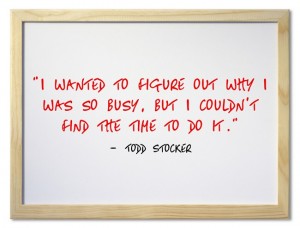 Be honest. How many free books have you downloaded but not yet opened? How many courses have you enrolled in but not completed? How many mailing lists are you signed up to that you don't get around to reading? Have you been promising yourself you would sail around the world one day, but still haven't done that? Planned to write a novel but still haven't got started?
It's not that you are lazy. In fact it's exactly the opposite. So much good intention. So much self improvement. But sadly, there are only so many hours in the day.
Be honest. How many free books have you downloaded but not yet opened? How many courses have you enrolled in but not completed? How many mailing lists are you signed up to that you don't get around to reading? Have you been promising yourself you would sail around the world one day, but still haven't done that? Planned to write a novel but still haven't got started?
It's not that you are lazy. In fact it's exactly the opposite. So much good intention. So much self improvement. But sadly, there are only so many hours in the day.
Our modern world delivers nearly everything we could possibly want, twenty fours of every single day. We see all sorts of opportunities for things we could do and learn and be. This can ignite our passions and fuel us on to explore such exciting possibilities. But just because so much is possible, it doesn't mean we have to do it all. And we certainly don't have to do it all today.
Most of us add an inexhaustive list of things we 'should' do, or things we 'could' do to our list of routine daily activities, like our actual jobs, feeding ourselves, buying that birthday gift for a relative, and so on. No wonder our to do lists feel overwhelming. In part it is because we may not have drawn that distinction between things we must do (like eat dinner) and things we might do (like learning a foreign language, say). So these extra tasks hang over us. They cast just a little shadow at first, and perhaps we don't notice them much, much less recognise what it is that is actually weighing over us. But eventually they become oppressive, especially when they accumulate.
So the first step is to figure out which of the tasks on our list fall into the 'might-do' category. One option is to create a separate list more appropriately titled, so that you can remind yourself that these are aspirational possibilities rather than chores you have still not completed. A second option is a suggestion from Arianna Huffington's new book Thrive. She says you can complete a task simply by crossing it off your list. You don't have to do everything. Really... you don't.
Another reason a to do list is overwhelming is that we are never quite sure we have done enough. We want to exercise regularly, meditate regularly, read more, improve a particular professional skill. We might even have been to enough training seminars to know that we need 'SMART' goals. This may mean we have set ourselves minimums, like 3km of running 3 times per week. Do this for all the tasks on your list and you have given probably set enormous expectations for yourself.
In itself that is not a bad thing, but we have to be fair to ourselves and aware of our current capacity. As James Clear points out, we should only expect that which is sustainable, by setting upper bounds as well as lower bounds. This is a lesson from the corporate world. Southwest Airlines chose to place an upper bound on their company growth in order to give themselves a margin of safety and avoid burning out. It seemed to work for Southwest, and it makes a lot of sense for us too as James Clear explains.
Figuring out how much of an activity is too much for us in a particular day or week, leaves us the space to rest and creates space for the next item on the list. It also may leave us with a better sense of accomplishment.
If your to do list overwhelms you it is a good indication that you need to go back to what is truly important to you. What are you goals and values? Now pick your top 3-5. Make sure every item on your list is in line with one of those 3-5 goals and values - if not cross it out, or at the very least put it on a separate list. Be kind enough to yourself to make sure you do not have unrealistic expectations. Life is too short for that.
“Busyness is not a reason for not getting other things done. It is an excuse for not claiming your true priorities.” Alan Cohen
A peep into my 10 minute journal
Can you 'fake it till you make it' and still be authentic?
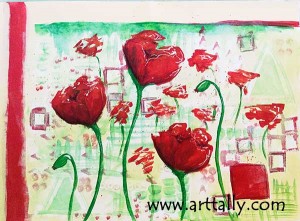 Whether you are reading about management, leadership or personal development, authenticity is one of those ever present buzzwords. We all strive for authenticity. But can being authentic prevent you from growing?
Whether you are reading about management, leadership or personal development, authenticity is one of those ever present buzzwords. We all strive for authenticity. But can being authentic prevent you from growing?
It comes down to what we mean by authentic. For most of us we think of this as having a clear sense of self, and staying true to that self. Making sure that you say as you feel, and do as you say. Your authentic self is your own unique blend of talents and attributes, the qualities that make you, you. It is not your qualifications or the things you think you should believe or be or do.
So what happens if you are trying something new and stepping out of your comfort zone? If you take up a more senior role, or branch out into a new area it seems inevitable that you will have some level of doubt, discomfort and lack of confidence. Don’t you need to ‘fake it till you make it’? Or would that be inauthentic?
If your answer was yes, then it is possible that your rigid view of authenticity could prevent you from growing. INSEAD professor Herminia Ibarra, suggests that the solution is to try and be more ‘adaptively authentic’. If we are too introspective and follow our old narratives too rigidly we are not giving ourselves permission to try anything new. We reinforce our existing stories and beliefs and limit our potential for discovering something different and possibly better.
To discover your authentic self you need to be clear about what it is that you value. Not what you think you should value, but what is actually important to you. Our past achievements are not these values. Hopefully what we have achieved is in line with our values, but these achievements should not become our sense of self. That kind of thinking drastically reduces the chance of further development.
For example, you might know that you are a good employee - you have been one before. You count it as an achievement. Being a good employee is as a result of your acting in accordance with your values of reliability, co-operation, diligence. But it does not mean you are only an employee or that it would be inauthentic to be anything else. Just because you are or have been an employee doesn't mean you can't become say, an entrepreneur. Focus on those values. Being reliable, cooperative and diligent can make you a good entrepreneur too.
Taking on a new role is going to feel uncomfortable - of course. The new entrepreneur is a beginner at being an entrepreneur and we all deserve to be able to give ourselves permission to be a beginner. Your authentic self knows you are a little scared and worried that you don’t really know what you are doing. I don’t think you need to be sharing that with the world to remain authentic. I think you can be aware of being a beginner, and be okay with that. Learn as you go, authenticity intact. There is a time and place to share your doubts. Choose that time wisely. Find a mentor and tell them... not your first client. When you get that promotion to manager don’t reveal your insecurities to your new staff. That’s not authenticity, it's poor management.
Social media shines the spotlight on the whole issue of authenticity. Celebrities and politicians are often under scrutiny for having artificial profiles on social media. But the reality is that we are all complex beings. We are all different things to different people. Do we really need to see every facet of a person in their social media profile… I think not. As long as we are clear on our own values and are acting in accordance with those values, being selective about what we reveal, when we reveal it and to whom is not inauthentic. It's just smart.
We grow by stretching the limits of who we are.
“Feeling like a fake can be a sign of growth” Herminia Ibarra.
Get yourself a colouring book....you know you want to
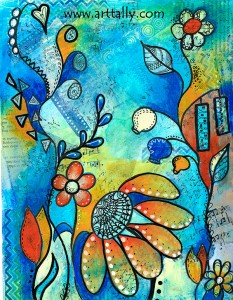 I bet most of the things on your to do list today are useful, important tasks. I bet they are mostly for everyone else. You are planning meals, collecting dry cleaning, meeting your boss’s needs, doing the school run. It’s all good. That’s what we do.
I bet most of the things on your to do list today are useful, important tasks. I bet they are mostly for everyone else. You are planning meals, collecting dry cleaning, meeting your boss’s needs, doing the school run. It’s all good. That’s what we do.
But you need something for you, too. Something just for you, that you do only for fun. Something that doesn’t really matter. Something you are not accountable for. Something you wont be judged on. Something easy, soothing, relaxing. It might even be your secret. But it doesn’t have to be. Like hundreds of chic French women, you might want to get yourself a colouring book.
No, hear me out…. A grown up colouring book. There are more and more of them available. In fact as I write this, the number one bestseller at www.bookdepository.com is Joanna Basford’s Secret Garden. Yes. It’s a colouring book. And guess what number 2 is? Joanna Basford’s orginal colouring book, Enchanted Garden. The top twenty bestselling books at the book depository currently includes no less than 4 adult colouring books.
Think of it as a purposeful activity if you must. A creative kickstart for some, like bestselling author, Joanna Penn. Joanna uses it as a way to get over a creative block and get writing again. It is an easy way to take the pressure off and soothe the muse.
But really, it is therapy. A way to relieve tension and anxiety. It's easier than meditating. Cheaper (and less intrusive) than a counsellor. Sitting down and colouring is pure escapism. It is active meditation. Mindfulness. The world slides by and you hear only the gentle scratch of the pencil tip on the paper. You feel the silky crayon glide satisfyingly over the paper. Glorious colours of your choosing wash the pixels out of your eyes. Who doesn't need a reprieve from those screens?
Remember when you put that first chunky crayon in your toddler’s clumsy fist? We watch our children delight in making marks and relish all that colour. We know it is good for them. That they are playing, learning, growing. As instinctively as they know what to do with the crayon, we know instinctively that we are nurturing them and their creativity. Why do we think we don't need or deserve that anymore?
I would be prepared to bet that you have plenty of juicy art supplies in your house already. You bought them for your children, didn’t you? When you were sitting at that restaurant and whipped out the crayons and paper to entertain your child while your order was prepared, you felt a twinge of longing to join in. A small twinge perhaps… suppressed… but it was there… you know what I am talking about…. You are not the only one - it is exactly how this whole project of mine got started.
So go on - get yourself a colouring book. Raid your kids’ art stash when they are asleep or at school. I can promise it will be fun. You know those scented markers are calling you...
How to get creatively unstuck in 10 minutes
The creative voice is a quiet one. Sometimes, barely a whisper.
I think I'd like to draw. (Or paint, or write, or sing.)
She is earnest, hopeful and painfully shy. So easily shouted down by her noisy big brother's torrent of 'buts'.
But you are rubbish at drawing...
But what would you draw...
But you will make a mess...
But you don't even know where to start or what supplies to use...
But you should be doing something more useful...
Steven Pressfield calls this Resistance. The opposing force that fights our creative tendencies. To me it is the bullying brother of the little creative spirit. Cruel, perhaps, but protective. There to keep the fragile creative soul safe by preventing it from stepping out of its comfort zone or trying anything new.
Being safe is all very well, but it leaves you with a creative block. Recently, I have found out how to get creatively unstuck in 10 minutes.
Rather than bullying that creative spirit into inaction, all it needs are some boundaries. Just like a small child.
I am taking Juliette Crane's online class called 'Bliss', in which Juliette talks about regaining the fun and freedom of creating by doing little 5 or 10 minute paintings. Well, she is quite right.
I had managed to make drawing and painting feel like an overwhelming task that I could not fit into my day for so very many reasons. But adopting this technique of a ten minute journal has really helped. Often it spurs you on to do a bigger project, but even if it doesn't, you have had the delicious little pick-me-up of a quick play with colour and line.
So the rules of my ten minute journal are designed to create a happy, safe and fun place where I can just enjoy the process of drawing and painting, liberated from those 'buts'. They go something like this:
the journal is small (and square which I love, but I don't think it matters!)
the paper is nice enough to take watercolour but not so expensive that I will feel bad about 'messing it up' (life is too short for bad paper, as Jane Davenport would say)
each painting takes 10 minutes
I can only use watercolours and black pens and white pens
colours are limited to a palette of three (yes, I break this rule often... and usually regret it)
each picture includes a character (e.g. a face, a figure, maybe an animal or bird)
The good thing is that these limits are totally liberating. I am using my travel watercolours and a waterbrush so I can do this anywhere - usually on the couch in front of the TV. I don't have to make decisions about what to draw and what materials to use. Each picture is going to be done in 10 minutes so it's never going to be perfect. Some times I love them, sometimes I really don't. Either way it doesn't matter. In ten minutes I will turn the page and forget about it.
Try it and see.
Abandon perfection and just enjoy being creative.
Your life purpose is not that complicated
 Your life purpose is not that complicated, after all.
Your life purpose is not that complicated, after all.
Hundreds of thousands of books have been written on the subject of finding your life purpose. For many of us it is the pursuit of a lifetime. While they say that the unexamined life is not worth living, I am finding that too much examining is not much of life either.
So it is with considerable relief that I stumbled upon some of the most helpful advice I have found so far on a topic I spend a good deal of time pondering. The Teal Swan explains that all of us ultimately have the same life purpose - to find joy. And that to find your ‘passion’ and what you should be doing with your life all you really need to do is follow what brings you joy.
"Find out where joy resides, and give it a voice far beyond singing. For to miss the joy is to miss all" Robert Louis Stevenson
Identifying your life purpose doesn't have to be some grand decision or declaration about the whole of your life. It can be as simple as using this question in order to make the simplest decisions in your every day life. That is information I can use. A structure I can implement. It makes so much more sense to me. Pyramids aren't built in one sweeping gesture, great novels aren't written in a day. They build over time, stone by stone, word by word.
So if you want to know if you are living your life ‘on purpose’, all you need to do is ask yourself ‘what can I do today to bring joy?’. As a guiding principle this really works for me. Trying to identify and articulate your personal values, your passion, your purpose seems daunting. Overwhelming. But when trying to decide whether to say yes or no to an offer you receive, whether to go to place A or place B, asking yourself which alternative brings you joy is much easier to implement. It is also a way to use your intuition. To try to tune in to your own inner voice and figure out what brings YOU joy. Not what you think you should choose, what you have been conditioned to believe is the ‘right’ thing to do. Far easier to do this in each small specific circumstance than to try and identify one grand impressive purpose. One big thing that you are supposed to achieve in your life.
And then slowly, just like each one of those stones in the pyramid or words in the novel, these little choices made by following your joy, show you what your life purpose is. Because life is how we pass each day, not just our grandest achievements. Making the small decisions in line with the guiding principle of what brings you joy will lead you to your grand achievements.
5 Free online art classes
Free online art classes make my heart sing! The online art community is such a generous one. So if you have been thinking about trying something creative but are wondering whether an online art class is for you, I just might be able to help you out.
These are the free classes that I have come across and taken in the last couple of years. Check them out - there might be one that is just right for you.
Art Heart and Healing
Tamara Laporte offers a 4 week mixed media course called Art, Heart and Healing which over 2000 students have taken. As well as learning many mixed media techniques, this class also offers a chance to experience the more therapeutic benefits of art. If that does not appeal, don’t let it put you off the class! Tam has an inclusive, engaging style and manages to pack an enormous amount of art advice and techniques into each lesson. Whether you want to ignore the healing side or not is up to you. And don’t worry if you are new to art, the beginner is well catered for.
Total Alignment
Connie Solera at Dirty Footprints studios offers a free painting course that comprises 5 lessons all aimed at getting you in Total Alignment with your creative source. It is a gloriously liberating journey into fearless painting. This one is for everyone, whether you have never painted before or you have plenty experience but just feel a bit stuck.
I am Free
Marieke Blokland offers a free mini art journalling course, called I am Free. The course has 4 lessons, and gives you a chance to see Marieke’s terrific videos. It is clear that a lot of effort goes into producing them. She's a doll, and I just love her quirky whimsical style!
Finding your muse
Alisa Burke offers a free course all about how to find your muse. I love her straight forward approach. Simple, inexpensive supplies are used, making this a no excuses prompt to get out and draw. This free course has 6 mini lessons and includes some high speed video of Alisa working in her sketchbook - that alone will probably get you motivated - it certainly worked for me! This class is about getting inspired, not about learning art techniques.
Strathmore Online Workshops
Strathmore offer a series of workshops through the year. Unlike the four classes listed above, these classes are not 'permanently' available. The first workshop in 2015 starts on 2 March (Traci Bautista), with other workshops becoming available at the beginning of May (Patti Mollica) and September (Maureen Wilson and Alphonso Dunn). You can go and register now (for free) and join the group for each workshop that takes your fancy.
If you have never taken an online art class before it can be hard to know where to begin. Luckily, some of the best art teachers offer free courses. This is brilliant on so many levels. You get a chance to see whether the online environment works for you. You get to see whether or not you like particular teacher’s style. And the best part is often participating in the class group or forum. I have found the student groups in all these classes to be friendly, welcoming and encouraging. You will probably find some fairly impressive art work there too - don't be intimidated!
"Never compare your beginning with someone else's middle." John Acutt
Art is fun whether you are 2 or 92. You don't even have to be good at it... (whatever 'good' might mean here!) So go on, give it a go. You know you want to.
And by the way, if you come across another free class or have some experience of these ones to share let us know. (If you can't see a comments box below there is a comments link near the heading)
Too busy or busy enough?
 |
| Abstract mixed media florals created in the online class 'Lifebook 2014' |
Hope when the moment comes, you’ll say “I, I did it all. I owned every second that this world could give……Yeah, with every broken bone, I swear, I lived” - One Republic
Getting started can be the hardest part of the task
 |
| Mixed Media painting created in the online class 'Lifebook 2014' |
Getting started can often be the hardest part of the task. Perhaps you have decided to go for a run today. The hardest part is actually making yourself put on your shoes and head out the door. Once you start, it's not so bad. In fact, you might even enjoy it. Maybe you set aside some creative time. Only now you are dithering between journal and canvas.... hmmm acrylic or watercolour? Perhaps your cursor is still blinking at the top of the blank page entitled 'Chapter One' ... Actually it's that voice of doubt that starts up at the beginning of the task that creates the inertia... you're not fit enough to get to the end of the street... you really dont know to handle watercolour... you write boring stories... this is going to be a waste of time that you could have spent doing something more useful, like the laundry.. So what to do about it? Here are four strategies you might like to try...
1. Just do it
Listen to the wisdom of Nike's marketing department and 'just do it'. Just start as quickly as possible. Get to the door right now without thinking about it, close it behind you and get running. Grab the first supplies you see and put pen to paper. Open that document and just start typing. The trick is in the speed. Not allowing time for the voice of self-doubt to get a word in.
2. Embrace the Doubt
Was it too late? Did those negative vibes creep in already? Give them their full voice. Grab a piece of scrap paper and write every negative thought, every possible reason for not doing the task, everything that might go wrong. Don't edit or format or worry about spelling - just spew it all out. Once you have done this you might just find that none of those reasons are convincing. You might even see what protective messages they convey, and be able to reframe them more positively. It might just make you more motivated than ever.
3. Bribery
Look... it works on five year olds, so it is worth a shot. Promise yourself a reward. Find the thing on your day's to-do list that you most look forward to doing and tell yourself that you will do that once you have finished this task you are struggling to start.
4. Instant Gratification
Try the polar opposite of the bribery strategy. Marney Makridakis says that "what moves us moves us". In other words, that task that you find enjoyable and fun, the one you are looking forward to will actually give you a bit more momentum. So do it first. If you really want to make a collage or splash around a bit of paint rather than this other thing you are putting off then go ahead. Doing the fun task will energise you and probably give you the boost you needed to take on the job you have been struggling to start.
What is art for?
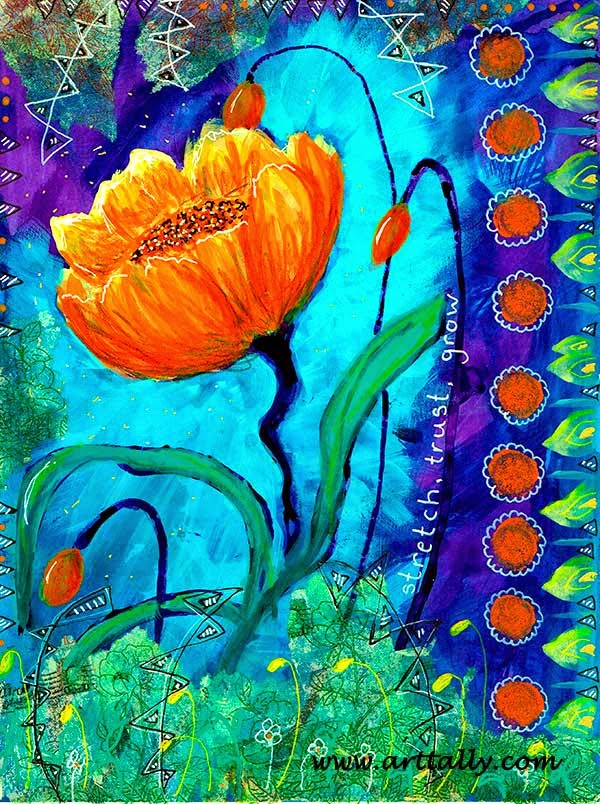 |
| Mixed Media Painting created in the online class 'Lifebook 2014' |
Sometimes I make some art. Maybe a journal, maybe a painting, or just a doodley sketch. Then my Inner Librarian leans over to take a look. "Hmm... " she says. "What is it for?" Thanks to both nature and nurture I am a deeply practical person. Art is fairly new but I have always been compelled to create. And always there is the question... what purpose does each creation have? One conclusion I often draw is that it seems easier to see what art is for if it is good art. But this is not a satisfactory answer at all. I get stuck in a loop of circular logic. 'Good' is subjective. Contextual. So in order to assess whether art is good, I need to know what it is for. Something is 'good' if it does what it is supposed to do. So what is art supposed to do? Alain de Botton has given the matter some thought. I came across this great little video that articulates his optimistic view on the question. It's one of those funny things... most people that make art worry that it is not good enough, and most people that look at art worry that they don't understand it. Perhaps we are all trying too hard.
The purpose of art is washing the dust of daily life off our souls. Pablo Picasso
Inspiration from famous artists: Joan Mirò
 |
| Miro inspired abstract in my sketchbook (following Carla Sonheim's exercise in the book 'Drawing Lab') |
The trouble with being a self-taught artist is that I can’t help wondering what it is that I need to know. What did I miss when I was learning calculus and consolidations instead of being in art class? Something I definitely know very little about is the artists of the past. Drawing Buddy and I made a start on filling this gap a little while ago. You remember Drawing Buddy? She is the one who is working through Carla Sonheim’s Drawing Lab with me. Well, in between all the tea and talking.
Anyway, Carla has a section on famous artists. We started with the Spanish artist Joan Mirò. No particular reason for selecting Mirò to start, but a surprisingly apt choice. Mirò went to business school because his parents advised him to choose a ‘sensible’ career, like bookkeeping. He apparently had a breakdown and consequently abandoned the business world entirely. (I hear you, my brother…) Here are another few fun Mirò facts…
- Mirò was a surrealist painter and sculptor known for using automatic drawing. No, not the paranormal kind – the kind where you allow your hand to make ‘random’ marks on the page. Messages direct from the subconscious, you see. Well, I love starting a doodle like that – didn’t realize it was a Thing.
- Along with Josep Royo, Mirò created the World Trade Center tapestry which was a little over 6m by 10m and weighed about 4tonnes. It hung in the South Tower from 1974 until it was destroyed in 2001
- Mirò’s Painting-Poem sold in 2012 at Christie’s for $26.6million. It includes the words “le corps de ma brune puisque je l'aime comme ma chatte habillée en vert salade comme de la grêle c'est pareil”. Now I know my French is rusty, but that really does say something like ‘the body of my brown since I love it like my cat dressed in green salad like hail it’s the same’, doesn’t it?
 |
| Painting-Poem by Joan Miro (1893-1983) |
Well I still don’t know much about cats dressed in green salad, but I did enjoy making a Miro inspired abstract in my sketchbook. I think I might just do another one.
The painting rises from the brushstrokes as a poem rises from the words. The meaning comes later. (Joan Miro)
Are you preparing or procrastinating?
 |
| Mixed media mermaid in a Dylusions Journal |
A little while ago Thing Two and I were both down with the the flu. We spent days on the couch, good for not much more than TV and tablets. Where would we be without the internet? I was feeling jolly pleased with myself, actually. I felt like I was rather productive despite being under the weather. I gave my Skillshare membership a real workout, taking classes on watercolour painting, pattern design and fashion illustration. I watched endless YouTube videos on art and ukulele tutorials and Eckhart Tolle's view of the world. I learned a lot. I was inspired. All of this is great if course, but I recognise it as a familiar pattern. We have no lack of information, having access to just about anything we want to know. But there is no substitute for doing. The first step is acquiring the information, but it is not much use if we don't start applying it. A bit of preparation is always going to be important whether you are starting a new business venture, taking up a new hobby or acquiring a new life skill. But there will always be another book to read, another online course to take, more data to gather. The preparation phase is an exciting place to be. But it is also a safe place. Fear keeps us from moving out of preparation into action. Preparation becomes procrastination. I don't think anyone feels perfectly ready, in reality. At some point, you have to declare your research sufficient, your training adequate. There will always be doubt as to whether you are going to sink or swim. The only way to find out is to jump in the water.
"Procrastination is opportunity's assassin." - Victor Kiam
Why time constraints may actually help you get stuff done
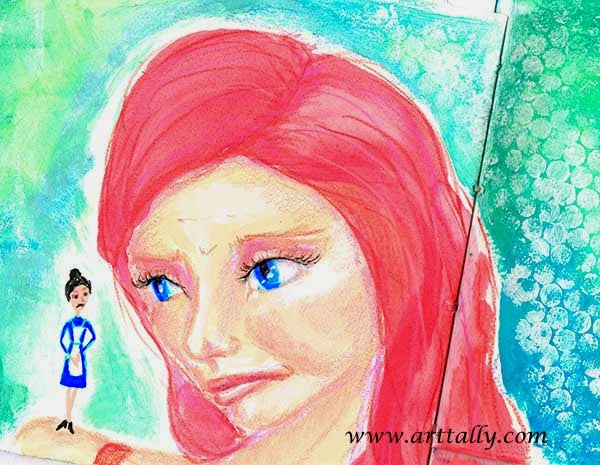 |
| Art journal page created in Jane Davenport's online class Frolicaholic |
The other day I had one of those long to-do lists that leave you in doubt that you have any hope of achieving them all in 24 hours. Then a friend rang. A friend I hadn't seen in quite some time. A spur of the moment catch up was suggested. My favourite kind! The angel on my one shoulder shook her head. (She can be a little officious and bossy. In fact I am not even sure she is an angel.) Clearly she thought the sensible, mature thing to do would be to attend to the chores on the list. The little devil on the other shoulder was skipping from one foot to the other..." What to-do list?" No prizes for guessing who won. The curious thing is that I actually managed to achieve both. I met my friend and I did all the other things I had planned for that day. It turns out that the tasks on our to-do list expand and contract to fit the time we allot for them. Reducing the time available focuses the attention. It seems to be an effective way of encouraging the mindfulness that can be so elusive. With less time we let go of any ideals of perfection and complete the tasks with the minimum investment of time and effort required for an acceptable result. Which is actually the definition of efficiency. When ample time is available it is the possibilities that can be overwhelming. It is not dissimilar to that pristine new canvas or blank art journal page. A trick that I have learned from different art teachers is to impose some constraints. Pick only 4 art supplies at random and limit yourself to using only those. Every time you add a colour make it a rule to use that colour 3 times on the page. Overcome writer's block by setting a timer and writing anything and everything that comes into your head until the timer goes off. Constraints don't reduce creativity, they enhance it. If necessity is the mother of invention then constraints must be her big sisters or, at the very least, distant cousins. I think it is true what they say.... if you want something to get done, give it to a busy person.
3 problems with following your passions
 |
| Mixed media journal page created in Jane Davenport's online class Create Emotion |
There was a rather annoying woman I used to work with who used to trot about saying irritating things like, " Find a job you love and you will never work a day in your life". Well yes. That is what Confucius said. Clearly no one sets about looking for a job they don't like. Do they? If you have reached one of those flat spots in your life and are wondering how to shake things up a bit, it won't be long before you are advised to 'follow your passions'. If you are considering a career change the advice is usually to think of the things you choose to do in your spare time and consider pursuing those more seriously. In other words, think about your hobbies. What you choose to do as a hobby is what lights your fire, makes your life fun and enjoyable. Hobbies give you a break from the routine. They decrease stress - the bad kind, and promote eustress - the good kind, which gives you enough of a challenge to feel excited about what you are doing. There is the possible sense of accomplishment, without a lot of pressure. The fun is in knitting the beanie with your own two hands... it doesn't really matter if turns out to be hideous, does it? Presumably we are all agreed that work should ideally be fun. Something we enjoy. Something we actually want to do. So making your hobby into your job can only be a good thing. Or can it? I see at least three problems: 1. Making your hobby into work might just be a major passion killer
- what you love to do
- what you are good at
- what someone will pay you to do
Are artists lonely?
 |
| Mixed media journal page created in Jane Davenport's online class 'Frolicaholic' |
I have a Drawing Buddy. We meet once a week and draw and drink lots of tea. (Often more tea than drawing). I am so glad that we do this because I realise how easily I can disappear from the world into art. It has made me wonder whether artists are destined to be rather lonely.
Artists are usually the quiet thinkers. Writing, painting and drawing are solitary pursuits. Most of the time this is good. A chance to escape the noisy rush of life, even if only for a little while.
But does this mean artists are lonely? I think there is a difference between loneliness and solitude. Solitude is a choice.
According to Leo Babauta, solitude is the number 1 habit of highly creative people. He cites both contemporary and historic examples of the artist's need for solitude.
Sarah Lewis also talks about the need for temporarily withdrawing from the world in order to create. Creation comes from our inner private domains. So often we are being told to get our work out where people can see it, being visible and vulnerable. It is easy to forget that there is a need to spend time alone with our thoughts and our art before this can happen. Sarah speaks beautifully about this here, if you have a few minutes to spare.
I have only fairly recently realised how much I need a bit of solitude. But I appreciate in equal measure the chance to meet up with those that share my new found passion for art. I love a Facebook online class group. And I always enjoy my weekly tea and art catch up with Drawing Buddy.
"It is one of the blessings of old friends that you can afford to be stupid with them." Ralph Waldo Emerson
Drawing Buddy and I have each purchased a copy of Carla Sonheim's Drawing Lab for Mixed Media Artists. Each week we pick a Lab to do together. I am finding this book to be a really handy resource. It contains 52 exercises (or labs) which are fairly quick to complete.
- want a warm up activity to get going
- feel stuck and in need of a bit of inspiration
- have a few minutes to spare but are not sure what to draw
Should you... really?
 |
| Art Installation 'Here Lies Should' by Robyn deVries |
Sometime ago I was observing, in a conversation with a friend, the things that I thought I should be doing, what I should be content with right now. My friend shook her head.




